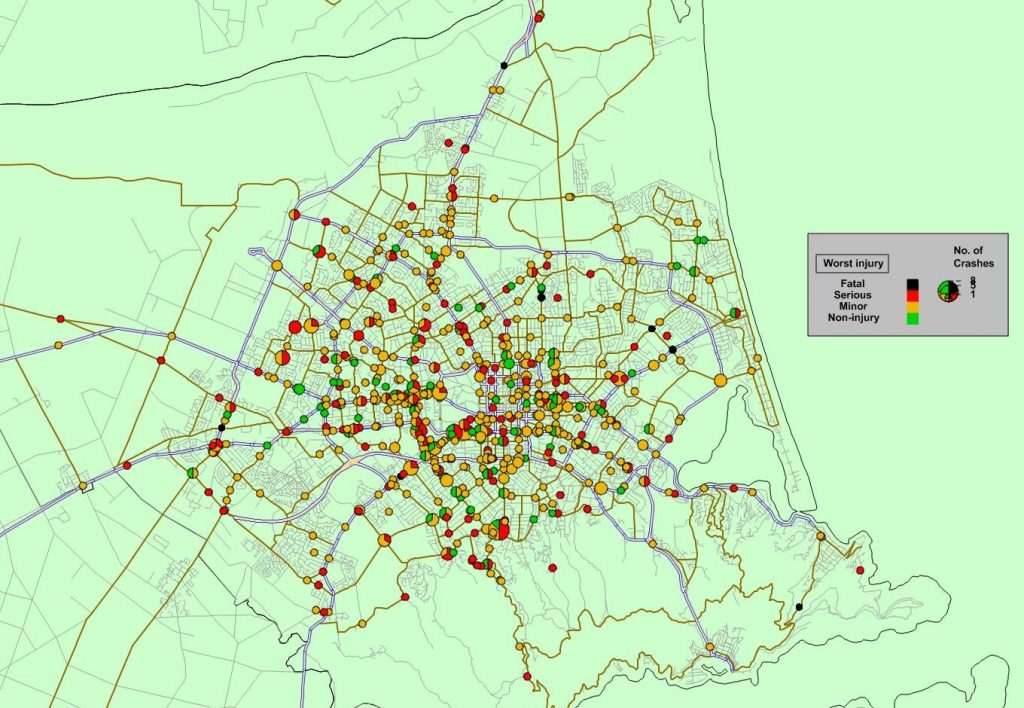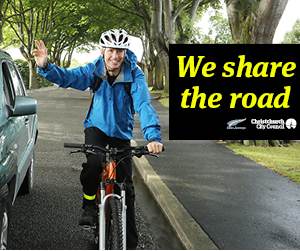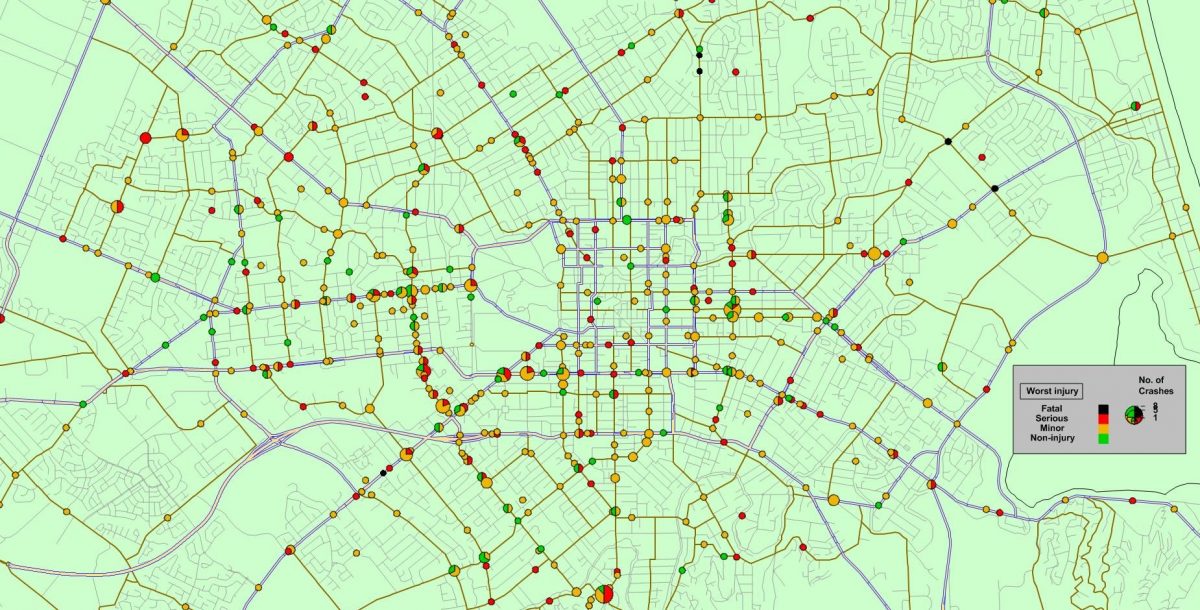I’ve been involved in a few recent discussions with the City Council about current cycle safety issues in the city; it is of course an ongoing issue in the city. To help inform me, I thought I’d have a look at some recent crash data, and I figured that many readers might also be interested in this too.

I pulled up (from the NZTA Crash Analysis System) all reported cycle crashes in Christchurch City for the five years between 2011-15 (while some 2016 crashes will be in the system, they can take 2-3 months to all appear). Over that time, 749 cycle crashes have been reported here (including 8 fatalities); the figures produced here show them coloured-coded according to their severities (a “serious” injury usually means hospitalisation), with larger circles representing locations where multiple crashes have occurred.
749 might sound like a lot of crashes; that works out to one every 2.4 days over this period. However our travel data tells us that over the same period there were approximately 90 million cycle trips made across the city. So that is roughly one reported crash for every 120,000 trips made – not so bad odds. We have to accept however that many cycle crashes are not reported to the authorities (especially lesser/no-injury crashes or those not involving a motor vehicle), and that’s not even considering the “near misses” that many people encounter too. So the actual crash rates observed by those on the road are generally worse again; my own personal experience (2 non-injury collisions in 15 years of cycling here) bears out a higher typical “hit rate” than the official stats. If you want to improve the quality of the data we have to work with, report that crash!
There are two ways that we can tackle the cycle safety problem:
(1) Identify locations where there are a high number of crashes and identify some treatments (usually physical works) to improve that location.
(2) Identify common crash factors/behaviours that are prevalent across a wide number of crashes around the city and identify some treatments (usually education or promotional) to improve that particular issue.
Considering the first approach, there are some clear problem spots that seem worthy of attention, and perhaps not where you might expect. Which location has the highest number of reported crashes in five years? That dubious honour goes to the Colombo/Centaurus/Cashmere/Dyers Pass roundabout with 8 crashes (including 4 serious ones). The Stanmore Rd / Hereford St roundabout is next (7 crashes), followed by two sites each on Whiteleigh Ave and Moorhouse Ave with 5 crashes apiece.

Whiteleigh Ave in fact features quite strongly as a problem corridor stretching from Barrington St all the way through to Straven Rd. Post-quake this route saw notable increases in both cycle and motor vehicle numbers, and the central part along Clarence St has no cycle facilities to speak of. The eastern end of Riccarton Rd also has a high crash rate; fortunately that is being addressed by the bus priority works along there. It is perhaps not surprising that many of the highest crash corridors are popular for cycling but don’t have any cycle facilities (or very constrained ones); the section of Papanui Rd through Merivale is another case in point.
Turning our attention to common cycle crash factors and, contrary to popular belief, getting hit from behind is not the biggest safety issue – most of your main problems are from traffic in front of you (e.g. 57% of crashes are “crossing/turning” movements). The top categories of factors identified (NB: can have more than one listed) are:
- “Poor observation” (55%)
- “Failed to give way or stop” (55%)
- “Incorrect lane or position” (18%)

I haven’t teased out here the relative attribution of faults to either party. We know that drivers are deemed to be fully or partly at fault in about 2/3 of all crashes, but clearly that doesn’t make the cycling party always blameless. I suspect that “poor observation” is mostly a bad habit of drivers whereas “failing to give way” may have a greater number of cyclists also guilty of this. The prevalence of “incorrect lane/position” probably correlates with many cyclists’ sense of motor vehicles passing them too closely, but it may also relate to cyclists being in the wrong place when making a particular manoeuvre.
Interestingly, trucks and buses don’t feature too highly in our cycle crashes (only ~6%), although we do know that they are often involved in some of the more serious incidents (like two fatalities in 2014). For all the purported concern about cyclists and pedestrians colliding, there are only four such crashes recorded in the database over 5 years. Most of the other statistics don’t really surprise me given the relative levels of cycling exposure in each case; e.g. 18% of crashes in dark/twilight conditions, 11% in wet weather, 64% at intersections.
While cycle crashes are a relatively small (and thankfully rare) part of our lives, they still merit some consideration of how things could be made better. Some of that might involve physical works (including the much-heralded Major Cycleways), while there may also be a need for educational or promotional initiatives as well to tackle common problems that are more widespread.
What cycle safety issues should City Council focus on?


On my daily commute one thing that really bugs me is cycle lanes that abruptly transition into parked cars on the shoulder, and cycle lanes that are interrupted just before an intersection so that you can’t get to the advance stop boxes without squeezing between two lanes of cars. Classic example, intersection of Selwyn and Brougham. Heading along Selwyn into town in the morning, it is often impossible to reach the advance stop box. Then, when you get to the other side, the cycle lane stops suddenly, and you need to pull sharply to the right, risking getting caught by cars maintaining their line.
In that same little area, something that happens often is that cars are queued up at a major intersection, and the queue crosses an intersection with a side street. A car will turn through the gap in the queue to access the side street, often waved on by a helpful driver maintaining the gap, and cut straight in front of a cyclist — they can’t see us, we can’t see them until too late. Not sure what design changes could prevent this, but I am now extremely cautious whenever I see such a gap in a queue of cars.
When I used to bike Papanui Road a lot, I was often confronted by delivery and trade vehicles blocking the cycle lane, and because the median is wide in many places, effectively squeezing a bike into car traffic. Would love to see council enforce parking regs more strictly on people who are "just there for a minute" or treating being a tradie as a license to park wherever they like. I’d be curious to know how many crashes on Papanui Road, Lincoln Road, Whiteleigh have this kind of thing as a contributing factor.
Apart from the usual intersection issues (thankfully usually you can spot them before something happens), my main gripe are cars running red lights (yes, cyclists do this a lot as well but they usually put themselves in danger, not someone else, and we don’t bike at 50-60 km/h). I keep reporting the ones I see on my commute to police (bad driver form) and hope that it will show up in some statistics and make a difference one day. I have a feeling that NZ and chch aren’t very keen on red light cameras or speed cameras, though.
On a more positive note, it is amazing how much safer and nicer a street feels to pedestrians and cyclists now that the cbd has a speed limit of 30.
My least favorite roads to cycle on would be Bealey Ave, Ferry Rd (western end), and although I do cycle on it I am not a huge fan of Yaldhurst Rd cycling facilities (City side) as the cycle path always seems to disappear when you need it most! I look forward to see cycling improvements on Riccarton Rd. There are also numerous wide suburban streets which could be made a bit safer (or more pleasant to cycle on) just by painting solid white lines which remains a cost-effective measure.
Let’s add Fitzgerald Ave to the main routes that need a cycle lane. Because of Barbadoes being one way, it’s quite a long way to find a parallel route, and even then, Madras is pretty shit too.
Agree
Thank you Lenny for the article. Interesting data there.
On my daily commute my main worry is the car that makes a sudden turn left, and crosses my path (even when I’m ahead of the car and on a cycle lane) causing inevitable, and so far, a near miss. I confronted one driver once and her reaction was even more troubling than the actual incorrect maneuver. She fail to recognised that anything wrong was done :).
I would like to have a quick way of reporting. Should we develop an app? (what else in this age, right?) that can quickly collect data than can be then sent to the Police.
I would also like to see some TV add regarding this. We are lacking relevant presence in road safety campaigns. Happy to lobby on this if others are interested in this topic too.
Safe trips to all.
Northcote Rd heading West from the QE2 Drive/Main N Rd cross roads scares me. The two traffic lanes merge into one as they exit the crossing, there’s a sharp narrowing of the road form the bike lane side and the bike lane shrinks in width, all almost at the same point. This junction is off your map so can’t see if it has a bad accident record.
It’s shown on the first map, where it would suggest that there might be a couple of minor injury crashes there.
There are way too many intersections which reduce from two lanes "this side" to to one lane the "other side" and which are only marginally safe for cars on the merging side but a trial in cyclist confidence and resolve, not to mention safety. A two lane approach to an intersection may be two times the car park and effective use of limited road space in a sense and when vehicles are stationary but come the other side when vehicles are mobile and two lanes become its usually a merging problem from hell at peak traffic flows. And that’s just for motorists. Cyclists be damned in the typical estimation as its still as if most cyclists are tacitly instructed to bugger off by the brute force of road design on most busy roads most of the time.
When a lane is designated as straight through as well as turning we as cyclists are advised by the Road Code to "take the lane" straight through but I have to admit that in examples such as the below I have been more timid in doing so than I have wished and put up with motor vehicles passing by far closer than ideal – competitively merging in the do or die race to get to the next red light or compulsory stop 1.38 seconds faster they the other guy or gal.
The merge from QEII Dr to Northcote Rd westward from Main North Rd is one partcularly instructive example too bad already mentioned. Main North Rd. southward past Cranford St another. Grahams Rd northward over Memorial Ave, Grahams Rd northward over Wairakei Rd, Linwood Ave eastward over Hargood St-Keighleys Rd and Ferry Rd westward over Hargood-Radley Sts are others. That’s just off the top of my head. Just to begin…
I notice that the dot on the intersection where I came to grief is marked yellow for minor. So if 3 separate trips to the emergency department resulting in a total of 5 nights admitted, a year off work , and even after that year still requiring a visit to the specialist qualifies as a minor accident then there is a problem . Sorry, it was not that minor to me.
It would be great to have some paint on Colombo heading north at the intersection with Bealey. Left turning vehicles getting into lane just do not see the many cycles that are heading straight through the intersection whatever position they try to take.
Crashes are often coded on the basis of what the attending officer noted at the time of the incident, rather than any follow-up activity. So, for example, if someone is carted away in an ambulance they would usually code it as “serious”, regardless of what their actual injuries were. Likewise, a crash might have been coded as minor if the officer didn’t discern any serious injuries at the time (e.g. adrenalin can mask the pain until later) or it was reported later to the Police station. So it’s an inexact science; what’s probably of more value is that the incident has at least been recorded in “the system”.
Yeah, thanks Lenny , I guessed that. (-: . A long story best not retold.
Really interesting article there, if you’re interested and can send the data I would like to produce a heat map of the accident spots to provide another visualisation of the worst or better areas of the city. Email is supplied, cheers.
Ditto to all the problematic road design anti-features mentioned above. Cycle lanes disappearing all of a sudden and street side car parking intruding into cycle lanes probably top the list of exceedingly ill-considered carriageway design.
Traveling "inside" a traffic queue even in a cycle lane with traffic potentially turning left and immediately across one’s path or going for "the gap" in the queue considerately given if coming from the opposite direction are probably the most commonly encountered real and immediate dangers. I’ve found its worth standing up on the pedals for the latter in order to make oneself as visible as possible. As for the former? I cannot but say that failure on the part of a motorist to indicate their intention to turn left is routine – to be automatically expected. The ability of the cyclist (me; you?) to brake dramatically or deftly swerve rightward in such circumstances is a critical life saving skill.
Even when there are barrier poles its not entirely unusual to encounter a car making a sneaky lefty completely blocking the cycle lane if they are able to fit. Design flaw to make these cycle friendly features too wide even if as obviously demarcated "cyclists only" as they can be, methinks. This is not an entirely unusual occurrence at the intersection of Kahu and Straven Rds, for example.
I wonder how many accidents aren’t reported? After 30 some years of cycling with immense confidence I had my first ever "accident" with a motor vehicle recently. I swerved to miss the truck not looking at all which turned right across my path which I did avoid but couldn’t avoid the car looking even less right behind it. They assumed that if it was safe for the vehicle in front it was safe for them… Never assume… Although I nearly flipped completely I only received a graze. I didn’t report the incident, figuring that my going completely off at the motorist (if largely for dramatic effect) did the trick for the most part. At least she was appropriately apologetic.
I am very sceptical about those central city separated cycle paths.They were never designed for me, nor did I want them, and now I’ve seen them at current flows I’m not sure they were designed for anyone. Methinks they are too dangerous to use. I’ve so nearly been taken out by ignorant motorists and pedestrians having no idea what they are every time I’ve used them; and after giving them up to take the lane easily achieved on the roadway at 30kmph – if very lucky to be going 30 at all – seen others all too nearly taken out on the cycleway ostensibly quicker as well. Taking the lane whenever possible and practicable and making it impossible to be invisible (as if) will always be safer than assuming a motorist is going to see "you" when "you" are misguidedly keeping safe by riding out of the way, even in an designated cycle facility with even the most minimal connection with regular roads.
why not look at the data for the last 15 years from NZTA all online here :http://nzcrash.azurewebsites.net/crashesMap.htm
use the search functionality to view the details and limit the data to just cyclists or pedestrians or whatever. There is also a phone app that can show the crash hot spots listed on the site
this link will show fatalities in chch city
http://tinyurl.com/jqntfvk
you can get a more detailed report by clicking the link , then opening the search menu and selecting ‘view report’
I also disagree with your understanding of the importance of rear-ending crashes – here is a link:http://tinyurl.com/jeyb8pl
that shows over the last 15 years there has been 29 fatals from rear-end crashes
In those past 15 years, there have been ~150 cycle fatalities, so rear-enders are still only 20% of that. It’s also important to appreciate that fewer than 10% of all cycle crashes occur in rural areas but, due to the higher speeds, about half of all cycle fatalities occur there. So rear-end crashes will seem relatively prevalent when considering fatal crashes, but are fairly rare in urban areas (like Christchurch) where most people cycle. The moral of the story: keep an eye on traffic behind you when out in the country, but in town worry about what’s in front of you…